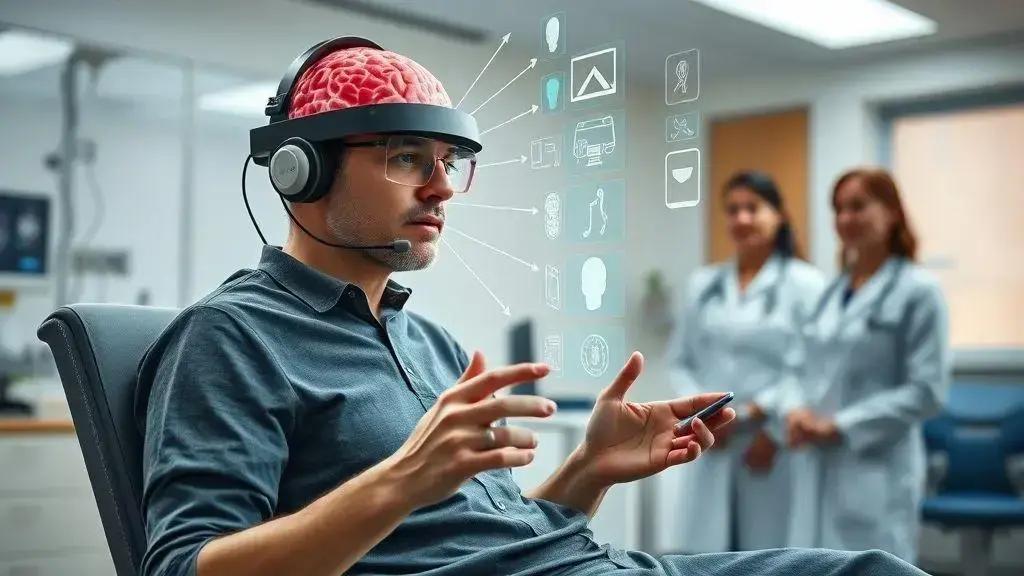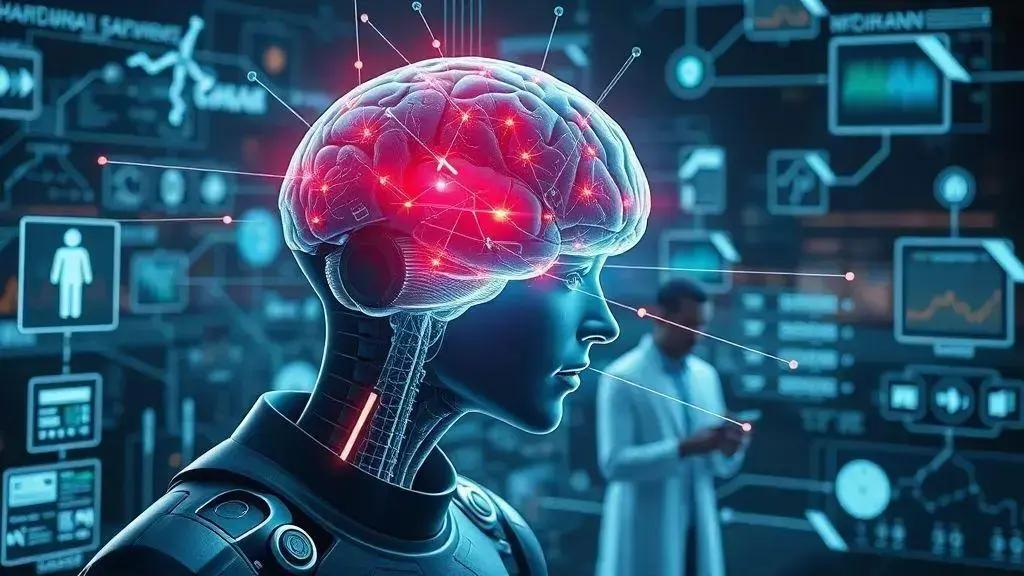Mainstream adoption of brain-computer interfaces is here
The mainstream adoption of brain-computer interfaces is transforming communication and rehabilitation by enabling direct interaction between the brain and devices, enhancing independence for individuals with disabilities.
Mainstream adoption of brain-computer interfaces is changing the way we interact with technology. Have you ever imagined controlling devices just with your thoughts? This technology could soon become part of our everyday lives, offering numerous applications from gaming to medical enhancements.
Understanding brain-computer interfaces
Understanding brain-computer interfaces is essential to grasp how these technologies can change our interactions with the world. These interfaces create a direct communication path between the brain and external devices, offering incredible possibilities for various applications.
One important aspect is the way these technologies work. Brain-computer interfaces (BCIs) can interpret brain patterns and translate them into actionable commands for computers or prosthetic devices. This means that people with mobility impairments could control a wheelchair or a computer simply by thinking about it.
Types of brain-computer interfaces
There are primarily two types of BCIs: invasive and non-invasive. Each has its own benefits and drawbacks.
- Invasive BCIs: Require surgical implantation into the brain and provide highly accurate readings.
- Non-invasive BCIs: Use external sensors placed on the scalp and are safer, but may have lower accuracy.
- Hybrid BCIs: Combine both invasive and non-invasive techniques for improved performance.
This understanding is crucial as it lays the foundation for how we can use these interfaces. Brain-computer interfaces are already being used in medical fields, such as helping patients with stroke rehabilitation or controlling artificial limbs. The potential benefits do not stop here; as technology advances, more sectors can tap into the transformative power of BCIs.
Real-world applications
Visionary researchers are exploring various real-world applications for these interfaces. Think of how they can assist people with disabilities by providing greater independence. For instance, a paralyzed individual could send emails or browse the internet using just their thoughts.
Moreover, BCIs are making waves in the gaming industry. Imagine being able to entirely immerse yourself in a game through your brain signals! This type of technology could revolutionize how we experience entertainment, making it more engaging and interactive than ever. The future looks bright as new innovations are continually rolled out.
Impact on healthcare and rehabilitation

The impact on healthcare and rehabilitation from brain-computer interfaces (BCIs) is profound. These technologies offer new ways for patients to regain function and improve their quality of life.
For individuals recovering from strokes or severe injuries, BCIs can enable communication and control over devices, which are vital in the rehabilitation process. By interpreting brain signals, these systems allow users to interact with their environment, creating opportunities for greater independence.
Applications in rehabilitation
BCIs have unique applications in several rehabilitation settings. They can assist in the following ways:
- Motor function recovery: Patients can practice movements through mental imagery, helping to retrain their brains.
- Communication enhancement: Individuals who cannot speak can use BCIs to express thoughts and needs.
- Therapeutic feedback: BCIs can provide real-time feedback to users, improving their engagement during therapy sessions.
Research shows that patients using these systems often recover quicker than those relying solely on traditional methods. With BCIs, therapy can transform from passive exercises into interactive experiences, encouraging participation and motivation.
The tech is constantly evolving, leading to more effective devices that can adapt to individual needs. As these advances continue, healthcare providers are exploring new ways to utilize BCIs in treating conditions like ALS, spinal cord injuries, and other neural disorders.
Future possibilities in healthcare
As brain-computer interfaces advance, the potential for personalized medicine grows. Imagine a world where BCIs could predict patient needs before they arise or adjust treatment plans dynamically based on brain activity.
Moreover, researchers are investigating ways to integrate BCIs with other technologies, like virtual reality, to create immersive and customizable rehabilitation environments. This combination can potentially enhance recovery outcomes and make the healing process more engaging.
Enhancing communication through brain-computer technology
Enhancing communication through brain-computer technology is a groundbreaking development for those with speech and movement disabilities. This technology opens up new pathways for individuals to express themselves in ways that were once impossible.
Brain-computer interfaces (BCIs) allow users to control devices using their thoughts. For many, this means they can communicate without traditional speech. Imagine a person unable to speak, using a BCI to select words on a screen just by thinking about them.
How BCIs improve communication
The main way BCIs enhance communication is by interpreting neural signals. These signals correspond to thoughts and intentions. The technology translates these signals into structured language. This allows users to form sentences and ideas.
- Direct thought translation: BCIs enable users to express thoughts instantly.
- Assistive devices: Devices can be controlled through brain signals, offering new modes of expression.
- Augmented reality integration: BCIs can work with AR to provide immersive communication experiences.
Additionally, BCIs can adapt to the user’s needs over time. Machine learning algorithms help these systems improve their accuracy based on usage patterns. This is especially important for users who may have fluctuating abilities or changing needs.
As technology continues to develop, we can expect further innovations in communication methods. Future BCIs could enable more complex interactions, allowing users a richer way to engage with the world around them.
The possibilities ahead
The possibilities for communication through BCIs are exciting. Educational tools can be developed with BCIs, helping students with disabilities participate more fully in class. Social interactions can become more meaningful, as users can share their thoughts and feelings directly.
Moreover, with the rise of social media and online platforms, BCIs could help broaden the scope of how people connect. Imagine sharing experiences and stories with friends using thoughts alone. This shift could redefine how we understand communication and relationships in a connected world.
Future trends in brain-computer interface technology

Future trends in brain-computer interface technology are paving the way for revolutionary changes in how we interact with machines and the world around us. As research progresses, we can expect significant advancements that will enhance capabilities and usability.
The ongoing integration of artificial intelligence with brain-computer interfaces (BCIs) is one exciting trend. AI algorithms can analyze brain signals efficiently, leading to improved accuracy in translating thoughts into actions. This means BCIs will become faster and more effective in real-time applications.
Emerging applications of BCIs
As we look forward, numerous applications are being explored across different fields. Here are some promising areas:
- Healthcare enhancements: BCIs will play a vital role in personalized medicine, tailoring treatments based on individual brain activity.
- Gaming and entertainment: Next-generation games could rely on BCIs for immersive experiences, allowing players to control the game with their minds.
- Education tools: BCIs could help in creating customized learning environments, adjusting to the cognitive levels of each student.
Additionally, BCIs might evolve to allow for a two-way communication system, where devices not only interpret brain signals but can send information back to the user. This could potentially lead to applications in virtual reality environments, creating more engaging and interactive experiences.
Challenges to overcome
While the future looks promising, there are still challenges in BCI technology. Concerns regarding privacy and security of brain data must be addressed. Moreover, developing user-friendly interfaces is crucial for broader adoption. The goal is to make BCIs accessible to everyone, not just tech-savvy individuals.
Technological limitations also pose challenges. Current devices may not accurately capture all brain signals, requiring ongoing research to enhance their precision and functionality. The evolution of materials and miniaturization of devices will play significant roles in this progress.
FAQ – Frequently Asked Questions about Brain-Computer Interfaces
What are brain-computer interfaces (BCIs)?
BCIs are technologies that create a direct communication pathway between the brain and external devices, allowing for control or interaction using brain signals.
How can BCIs enhance communication for people with disabilities?
BCIs enable individuals with speech or mobility impairments to communicate by translating their thoughts into commands for devices, providing greater independence.
What impact do BCIs have on healthcare and rehabilitation?
BCIs can assist in rehabilitation by helping patients regain motor functions and improving communication, leading to more effective therapy outcomes.
What are the future trends for brain-computer interface technology?
Future trends include enhanced applications in healthcare, gaming, and education, as well as addressing security challenges and improving user experience.





